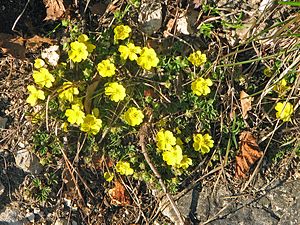Star-haired spring cinquefoil
| Star-haired spring cinquefoil | ||||||||||||
|---|---|---|---|---|---|---|---|---|---|---|---|---|

Star-haired spring cinquefoil ( Potentilla pusilla ) |
||||||||||||
| Systematics | ||||||||||||
|
||||||||||||
| Scientific name | ||||||||||||
| Potentilla pusilla | ||||||||||||
| Host |
The star-haired spring cinquefoil ( Potentilla pusilla ), also called fluff cinquefoil , is a species of the genus cinquefoil ( Potentilla ) in the rose family (Rosaceae). The specific epithet pusilla is derived from the Latin word pusillus for tiny, weak.
description
The star-haired spring cinquefoil is a perennial herbaceous plant that reaches a height of 5 to 15 centimeters. Since the rhizome forms runners, it comes to a lawn-like cushion growth. The leaves, which are usually five or rarely seven-fingered, are pale green. The leaflets have three to nine teeth. The leaves are loosely haired and show star-shaped serrated hairs at least on the edge and underside: on small pustules there are two to twelve tiny (0.05 to 0.1 mm long) unbranched individual hairs, in the middle of which there is a strong one up to 1.2 mm long Curry hair. However, the hair does not form fur felt in contrast to the sand cinquefoil ( Potentilla arenaria ). The lower stipules are narrowly lanceolate.
The flower stalks, which arise individually in the axils of the leaves, are hairy and stick out and almost always have long-stemmed glandular hairs. The five-fold flowers have a diameter of 8 to 12 millimeters. The golden yellow petals are slightly edged.
The flowering period extends from April to June. The star-haired spring cinquefoil shows a multi-level ploid series , with the chromosome numbers 2n = 28, 35, 42, 49, 56 and 70.
ecology
The pollination is done by insects.
Occurrence
The star-haired spring cinquefoil is a purely European plant species that is widespread in the entire Alpine region from the Maritime Alps to Lower Austria . The southern border of their area runs through northern Italy and Dalmatia to Bosnia-Herzegovina. To the east, the distribution limit runs through western Hungary, the Czech Republic and Poland. Their occurrence in Slovakia is questionable. In Germany, the star-haired spring cinquefoil is not only found in the Alps and in the Alpine foothills ( but possibly lost in Baden-Württemberg ), but can also be found in the Franconian Alb , and to the north as far as the Harz foothills and Upper Lusatia . However, as a critical species, further distribution is definitely possible.
This cinquefoil prefers dry to rocky grasslands and rises in the Alps to altitudes of 2350 meters. But it also occurs on sandy soils along rivers, as well as in sparse pine forests, on embankments and in park lawns. In Central Europe it is a species of the order Festucetalia valesiacae. In the Allgäu Alps, it rises in the Tyrolean part on the southern slope of the Rotwand up to an altitude of 1,300 meters.
Fodder plant
The crawler plurality of cube-Dickkopffalter species of the genus Pyrgus live on leaves of the star-haired Spring finger herb, such as the crawler from Zweibrütigen cube Dickkopffalter ( Pyrgus armoricanus ) from Rosy Grizzled Skipper ( Pyrgus onopordi ) from Southern small cube Dickkopf ( Pyrgus malvoides ) u. a.
swell
- Manfred A. Fischer , Karl Oswald, Wolfgang Adler: Excursion flora for Austria, Liechtenstein and South Tyrol. 3rd, improved edition. State of Upper Austria, Biology Center of the Upper Austrian State Museums, Linz 2008, ISBN 978-3-85474-187-9 .
- Henning Haeupler , Thomas Muer: picture atlas of the fern and flowering plants of Germany (= the fern and flowering plants of Germany. Volume 2). Published by the Federal Agency for Nature Conservation. Ulmer, Stuttgart 2000, ISBN 3-8001-3364-4 .
- Gustav Hegi : Illustrated Flora of Central Europe , Volume IV, Part 2C. Second edition, Blackwell Verlag, Berlin - Vienna, 2003. ISBN 3-8263-3065-X
Individual evidence
- ↑ Christoph Dobeš: The karyogeography of the Potentilla verna agg. (Rosaceae) in Austria - with additional information from Slovenia, Croatia, Slovakia and the Czech Republic. Ann. Naturhist. Museum Wien, Volume 101B, pp. 599–629, December 1999 PDF.
- ^ Erich Oberdorfer : Plant-sociological excursion flora for Germany and neighboring areas . With the collaboration of Angelika Schwabe and Theo Müller. 8th, heavily revised and expanded edition. Eugen Ulmer, Stuttgart (Hohenheim) 2001, ISBN 3-8001-3131-5 , pp. 541 .
- ↑ Erhard Dörr, Wolfgang Lippert : Flora of the Allgäu and its surroundings. Volume 2, IHW, Eching 2004, ISBN 3-930167-61-1 , p. 72.
- ↑ Ecology of cube-headed butterflies
Web links
- Star-haired spring cinquefoil. In: FloraWeb.de.
- Profile and distribution map for Bavaria . In: Botanical Information Hub of Bavaria .
- Potentilla pusilla Host In: Info Flora , the national data and information center for Swiss flora . Retrieved November 7, 2015.
- Thomas Meyer: Data sheet with identification key and photos at Flora-de: Flora von Deutschland (old name of the website: Flowers in Swabia )







